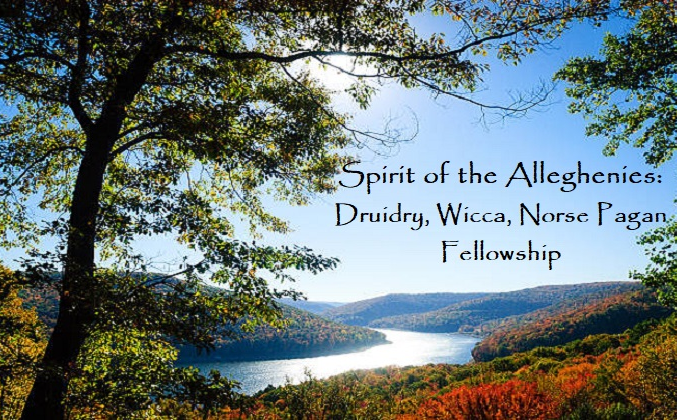
The ceremonial circle is a timeless symbol of sacred space and spiritual protection. Within Druidry, the act of casting a circle is a foundational practice that connects one with nature, harmonizes energies, and provides a haven for ritual work. The author is a Druid in the Order of Bards, Ovates, and Druids, and his work within that tradition influences the following article. While there are similarities between Druid traditions, other Groves may use different rites or practices to cast the ceremonial circle.
Druidry is deeply rooted in reverence for nature. Casting a circle is a means of attuning to the natural world and its rhythms and is therefore generally performed in outdoor settings, allowing practitioners to immerse themselves in the energies of the elements: Earth, Air, Fire, Water, and Nwyfre (Sacred Spirit).
To begin, Druids cleanse (smudge) the sacred space where the circle will be cast using Sage, Mugwort, Mullein, or another purification herb. The Druid defines the circle once the area has been purified of negative thoughts and intentions. This is accomplished by physically tracing the circle’s boundary with a wand, staff, or athame (or another ritual device such as the silver branch), always moving deosil (the sunwise/clockwise direction). Returning to the center, where a fire or candle is often placed to invoke Nwyfre, the Druid turns to face each cardinal direction in turn, invoking the Quarters: East (Air), South (Fire), West (Water), and North (Earth)—aligning with the elements associated with each direction. Animals are also often invoked as threshold guardians during the casting of the circle:
“We call upon the Hawk of Dawn, who circles the sky of the Rising Sun!
We call upon the Summer Stag, whose strength and vigor derive from the High Sun!
We call upon the Salmon of Wisdom, who dwells in the Sacred Pool of the Setting Sun!
We call upon the Great Bear, whose dwelling place is in the Starry Heavens above!

Casting the ritual circle connects the druid with the land. Some druids mark the quarters with natural elements like stones or flowers, and offerings to nature spirits, ancestors, and deities are made within the Druidic circle, accompanied by prayers or ritual chants expressing gratitude and seeking protection and blessings from the spiritual realms. The calling of Peace to the Quarters is a part of all Druidic rituals within the Order of Bards, Ovates, and Druids. The Druid faces each direction, in turn, and calls out:
“May there be Peace in the East! Awen!
May there be Peace in the South! Awen!
May there be Peace in the West! Awen!
May there be Peace in the North! Awen!
May there be Peace throughout all of the World!
Awen! Awen! Awen!”
***The Welsh word “Awen” means flowing spirit or inspiration and is a holy word and concept in OBOD Druidry used to call upon divine blessing.***

An Old Irish variation of the Casting of the Caim assigns qualities to each direction. In this version, the Druid begins in the West, direction of the setting sun and thus night, darkness, and beginning. The Druid proceeds in the deosil or clockwise direction, intoning:
An’t Iarthar, Fis (On-teer-her, Feesh)
An’t Huaidh, Cath (On-hoo-ah, Kah)
An Oirthear, Bláth (On-air-her, Blaw)
An Theas, Séis (On-hahs, Sheesh)
Flaitheas i Lárphointe (Flaw-hahs ih Lore-fween-tah).
“In the West, Knowledge
In the North, Battle
In the East, Blossoms
In the South, Melody
Sovereignty at the Center.”
We may offer the following explanations for the qualities assigned to each direction. The West is the place of Spirit and the home of the Salmon of Wisdom, who dwells in the Pool of Segais, surrounded by nine Hazel Trees. The hazelnuts fall into the pool and are consumed by the salmon, who become wise. The West is thus a place of great knowledge. The North is the symbolic direction of Elemental Earth and the home of the Great Bear, whose special province is food and medicine and who is often invoked in battle as a powerful totemic being. We speak here not only of the battles that occur in warfare but of the struggle for life to prevail against sometimes overwhelming odds. The North is also the place of Winter, and every year, the great community of nature, the plants and animals, and even human beings struggle to survive the bitter cold of the Winter months. The East is the place of the sunrise and new beginnings. It is the home of the Hawk of Dawn. It is also the direction of Springtime. Blossoms appear on trees and flowers bud in the Spring as the days grow longer and the Sun warms the Earth Mother. The Hawk of Dawn represents the birds, who also play a critical role in spreading seeds, which foster new growth across the lands. The South is the place of Summer, whose power and vitality are symbolized by the Stag. We hear the melodies of nature most acutely in the Summertime: the sounds of songbirds in the trees, babbling brooks, the humming of the cicada, and the snort of the stag in the thicket. At the center of the circle, the harmony and Balance of the Wheel of the Year is made possible by the Goddess of Sovereignty, who wisely governs over all Creation.
